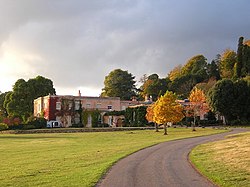Killerton
| Killerton | |
|
National Trust | |
|---|---|
 Killerton House | |
| Grid reference: | SS97340011 |
| Location: | 50°47’29"N, 3°27’28"W |
| Built 1778 | |
| Information | |
| Website: | Killerton |
Killerton is an 18th-century house in Broadclyst to the east of Exeter in Devon. The house and its hillside garden and estate have been owned by the National Trust since 1944 and are opened to the public.
The National Trust displays the house as a comfortable home. On display in the house is a collection of 18th- to 20th-century costumes, originally known as the Paulise de Bush collection, shown in period rooms.
The estate covers some 6,400 acres.[1] Included in the Estate is a steep wooded hillside with the remains of an Iron Age Hill fort on top of it, also known as Dolbury which has also yielded evidence of Roman occupation, thought to be a possible fort or marching camp within the Hill fort.[2]
Killerton House itself and the Bear's Hut summerhouse in the grounds are Grade II* listed buildings.[3][4] The gardens are Grade II* listed in the National Register of Historic Parks and Gardens.[5]
History
The manor of Columb John in the parish of Broadclyst was purchased by Sir John Acland (d.1620), MP and High Sheriff of Devon. The adjoining estate of Killerton was purchased a short time thereafter from Sir Thomas Drewe (d.1651) of The Grange, Broadhembury, Sheriff of Devon in 1612,[6] by his nephew Sir Arthur Acland (d.1610) of Acland in the parish of Landkey as jointure for his wife Eleanor Mallet.[7]

The present, Georgian Killerton House was built by Sir Thomas Acland, 7th baronet in 1778. The chapel was built in 1738 to the designs of Charles Robert Cockerell.
The garden was created in the 1770s by John Veitch, one of the leading landscape designers of the time. It features rhododendrons, magnolias, herbaceous borders and rare trees, as well as ice house and early 19th-century summer house. The surrounding parkland and woods offer a number of circular walks. Plans attributed to William Sawrey Gilpin (1762-1843) for a new drive from Killerton to Columbjohn (1820) were not implemented.[5]
A short play about of the meeting between Veitch and Gilpin was commissioned by The National Trust in the gardens of Killerton in mid 2016.[8]
Killerton was given to the National Trust by Sir Richard Dyke Acland, 15th Baronet and in September 2015 The National Trust commissioned a short drama to be staged on the site entitled The Gift, written by Eileen Dillon, telling the story of Sir Richard's decision to hand over his estate.[9]
Outside links
References
- ↑ "National Trust - Killerton". web page. National Trust. http://www.nationaltrust.org.uk/killerton/. Retrieved 21 April 2012.
- ↑ Sellmanm R. R.: 'Aspects of Devon History' (Devon Books 1985) ISBN 0-86114-756-1 - Chapter 2; The Iron Age in Devon. Map Page 11
- ↑ National Heritage List 1098331: Killerton House and ha-ha
- ↑ National Heritage List 1170706: The Bear's Hut north of Killerton House
- ↑ 5.0 5.1 National Heritage List 1000694: Killerton House gardens
- ↑ Vivian, Lt.Col. J.L., (Ed.) The Visitations of the County of Devon: Comprising the Heralds' Visitations of 1531, 1564 & 1620, Exeter, 1895, p.307, pedigree of Drewe
- ↑ Acland, Anne, A Devon Family: The Story of the Aclands. London and Chichester: Phillimore, 1981, pp.4-6
- ↑ National Trust Events at Killerton
- ↑ "Volunteering in very special places Volunteer, Killerton". National Trust. https://www.nationaltrust.org.uk/profiles/volunteering-in-very-special-places. Retrieved 5 July 2016.